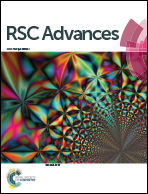Hydroxyapatite conjugated graphene oxide nanocomposite: a new sight for significant applications in adsorption†
Abstract
Great efforts have been made to develop efficient adsorbents in recent years. In this study, graphene oxide (GO) was synthesized and the surface chemistry of GO was modified by means of hydroxyapatite (HAP) conjugation in order to increase the number of active sites responsible for cationic dye adsorption. The obtained HAP conjugated GO nanocomposites were characterized using various techniques such as FTIR, RAMAN, XRD, TGA, FESEM, BET surface area and AFM. Herein, malachite green (MG) was used as a model dye and the effect of several parameters, including time, pH, temperature, adsorbent dose, and MG concentration, on the adsorption were investigated. The isotherm, kinetic and thermodynamic parameters were measured. The adsorption of MG was best described by the Freundlich isotherm with a pseudo second order kinetic model. In addition, the removal efficiency was maintained at 82% even in the fourth cycle, which supported the reusability and stability of the fabricated nanocomposite for cationic dye adsorption from an aqueous medium.


 Please wait while we load your content...
Please wait while we load your content...